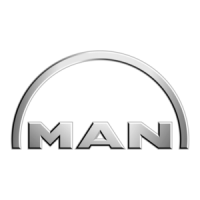MAN B&W 1.00
Page 1 of 2
MAN Diesel
MAN B&W ME-GI engines
198 91 51-6.1
The MEGI Dual Fuel Engine
ME-GI vs ME engine design
Although few technical differences separate fuel oil
and gas burning engines, the ME-GI engine pro-
vides optimal fuel flexibility. Fig. 1.00.01 shows the
components that are modified and added to the
engine, allowing it to operate on gas.
The new units are:
• A chain pipe gas supply system for high-pres-
sure gas distribution to a gas control block on
each cylinder
• Leakage detection and ventilation system for
venting the space between the inner and outer
pipe of the double-wall piping and detecting
leakages. Inlet air is taken from a non-hazardous
area and exhausted to outside the engine room
• Sealing oil system, delivering sealing oil to the
gas valves separating control oil and gas. Fully
integrated on the engine, the shipyard does not
need to consider this installation
• Inert gas system that enables purging of the gas
system on the engine with inert gas
The development in gas and fuel oil prices in
combination with the emission control regulations,
has created a need for dual fuel engines.
The ME-GI engine is designed as an add-on to
the MAN B&W two-stroke ME engine technology.
It allows the engine to run on either heavy fuel oil
(HFO) or liquid natural gas (LNG).
ME-GI injection system
Dual fuel operation requires the injection of first
pilot fuel (to start the combustion) and then gas
fuel into the combustion chamber.
Different types of valves are used for the injection
of gas and pilot fuel. The auxiliary media required
for both fuel and gas operation is:
• High-pressure gas
• Fuel oil (pilot oil by existing ME fuel oil system)
• Control oil for actuation of gas injection valves
• Sealing oil to separate gas and control oil.
Fig. 1.00.01: Gas module with chain pipes, gas control block and fuel gas double-wall high-pressure pipes
178 65 951.0

